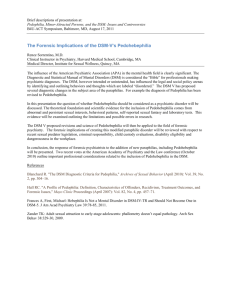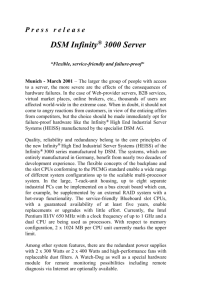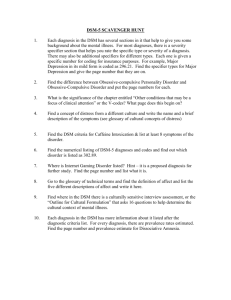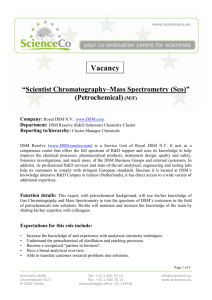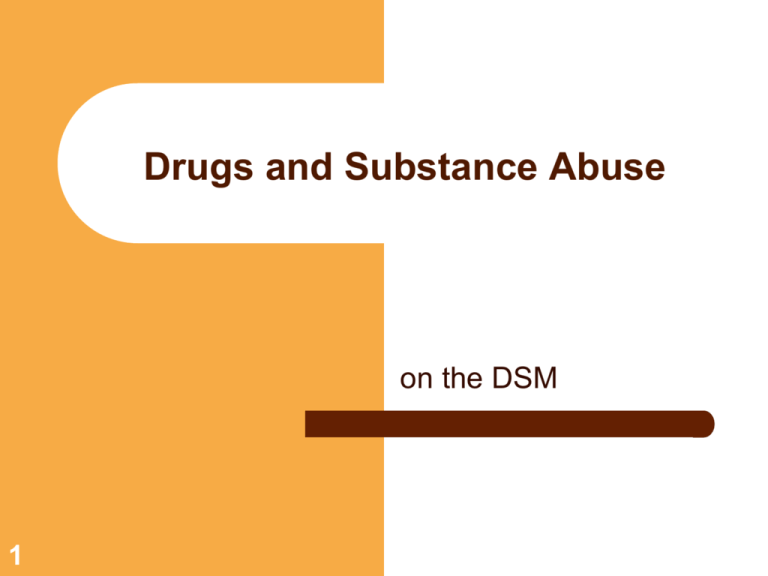
Drugs and Substance Abuse
on the DSM
1
Drug and Substance Abuse
on the DSM
Diagnosis:
1.
Substance-induced disorder (effect)
2.
Substance-related disorder (cause)
... dependence and abuse
2
Drug and Substance Abuse
on the DSM
Why drugs?
“Life as we find it, is too hard for us; it brings too many
pains, disappointments and impossible tasks. In
order to bear it, we cannot dispense with palliative
measures... there are perhaps three such measures:
powerful deflection, which causes to make light our
misery; substantive satisfactions, which diminish it;
and intoxication, which makes us insensitive to it.”
- Freud
3
Drug and Substance Abuse
on the DSM
Stress:
Task-oriented, problem solving
vs.
Defense oriented, emotion-focused response
4
Drug and Substance Abuse
on the DSM
1. Powerful deflection, which causes to make light our misery;
2. Substantive satisfactions, which diminish it;
3. Intoxication, which makes us insensitive to it
5
Drug and Substance Abuse
on the DSM
Forms of intoxication:
1. Sedation: alcohol, barbituates, benzodiazepines...
2. Stimulation: caffeine, nicotine, amphetamine, cocaine...
3. Fantasy: psychedelics, hallucinogenics, cannabis...
4. Narcotics: opium, morphine, heroin...
6
Drug and Substance Abuse
on the DSM
Alcohol:
BR: 6 8 10%+
LTR: 12 18 20%+
Genetics: concordance and adoption studies
(“modelling is a factor”)
7
Drug and Substance Abuse
on the DSM
Alcohol, biologically:
1. Increase in some neural activity
(e.g. monoamine and endorphin)
2. Decrease in other neural activity
(e.g. GABA and glutamate)
8
Drug and Substance Abuse
on the DSM
Alcohol, psychologically:
1. Elevation of positive emotionality
2. Reduction of negative emotionality
9
Drug and Substance Abuse
on the DSM
The conditioning perspective:
“Alcohol is consumed because it is reinforcing...”
1. Positive reinforcement
2. Negative reinforcement
10
Drug and Substance Abuse
on the DSM
“Types” of alcoholism:
1. Type I - binge type
2. Type II – persistent type
11
Drug and Substance Abuse
on the DSM
Treatment:
•
Recovery and relapse rates
•
AA and relapse prevention
• “apparently irrelevant decisions”
• “abstinence violation effect”
• controlled drinking
12
Drug and Substance Abuse
on the DSM
Comorbidity:
1. Drug as primary
(“primary alcoholism”)
2. Drug as secondary
(“dual diagnosis”)
13
Drug and Substance Abuse
on the DSM
Related organic disorder:
1. Alcohol amnestic disorder
•
•
“Wernicke-Korsakoff Syndrome”
Vitamin B1 (thiamin)
2. Alcohol withdrawal delirium
•
“Delirium tremens”
3. Fetal alcohol syndrome
•
•
14
“Fetal alcohol spectrum disorder”
BR and other issues
Sex
on the DSM IV
15
Sex
and the DSM IV
I.
Sexual dysfunctions:
II.
Variants and deviations:
16
desire
arousal
orgasm
pain
paraphilias
gender identity disorders (and sexual orientation)
Sex
and the DSM IV
History:
Reverend Sylvester Graham Dr. John Harvey Kellogg
17
Sex
and the DSM IV
History:
18
Kinsey
Masters & Johnson
Sex
and the DSM IV
History:
The old “Barbie Doll” approach...
and the newer evolutionary one:
mental and physical aspects
John Money
19
Sex
and the DSM IV
Understanding our sexuality:
Back to basics : Why sex?
20
What is different about sexual motivation, in evolutionary
history?
The adaptive functions of sex: reproduction and beyond
Sex
and the DSM IV
Understanding our sexuality:
The design of sexual systems:
21
“Releasers” (cues and rituals)
“Boundary conditions” (internal and external)
Sex
and the DSM IV
Understanding our sexuality:
The process:
a.
b.
c.
d.
partner location elicit desire
pretactile sexual interaction maintain arousal
tactile sexual interaction “acception”
intercourse “conception”
The problem:
The invocation and maintenance of motivation (“proception”)
22
Sex
and the DSM IV : Sexual Dysfunction
I. Sexual Dysfunction
Base rates:
Men: 31%
Women 43%
23
Sex
and the DSM IV : Sexual Dysfunction
1.
Desire: hypoactive sexual desire
and sexual aversion (diagnosis)
BR
NORC
Dx
Men:
5 16%
(0 - 3%)
Women:
2233%
(10% )
Dx issues:
24
“dysfunction” vs. problem
medical factors
Sex
and the DSM IV : Sexual Dysfunction
2.
Arousal: SADF and SADM (diagnosis)
BR
NORC
Dx
Men:
5 10%
(0 - 5%)
Women:
1419%
(6%)
Dx issues:
25
“erectile insufficiency” for men
vaginal lubrication for women
the relevance of negative emotional states (anxiety)
the relevance of the autonomic nervous system. (PNS/SNS)
Sex
and the DSM IV : Sexual Dysfunction
3.
Orgasmic: orgasmic dysfunction and
“premature ejaculation” (diagnosis)
BR
NORC
Dx
Men:
0 8%
(0 - 3%)
Women:
7 25%
(10%)
Dx issues:
the ejaculation for men
the “satisfaction” for women
26
Sex
and the DSM IV : Sexual Dysfunction
“Premature ejaculation” (diagnosis)
BR
Men:
Women:
NORC
Dx
21 30%
(5%)
?
(?)
Dx issues: comparative and personal criteria
27
Sex
and the DSM IV : Sexual Dysfunction
4.
Pain: dyspareunia and vaginismus
(diagnosis)
BR
Men:
Women:
NORC
Dx
03%
(0%)
? 15%
(3%+?)
Also: “Sexual dysfunction NOS”
28
Sex
and the DSM IV : Sexual Dysfunction
Sexual Dysfunction
Summary:
the problematic nature of the human sexual
response and its ramifications in society
29
Sex
and the DSM IV
30
Sex
and the DSM IV
31
Sex
and the DSM IV : Sexual Dysfunction
Therapies:
Masters & Johnson, and beyond
Tx issues:
o
success and spontaneous remission
o
relationships and individualized
assessment
32
Sex
and the DSM IV
II. Variants and Deviations
A.
Paraphilias and their relation to “sexual” offenses
B.
Gender identity and its disorders
C.
Sexual orientation and the controversy over
diagnosis
The concept of the “lovemap”
33
Sex
and the DSM IV : Variants and Deviations
A. Paraphilia:
Definition: “. . . reiteratively responsive to and
dependent on atypical or forbidden stimulus
imagery, in fantasy or practice, for the initiation
and maintenance of erotosexual arousal and
achievement or facilitation of orgasm.”
Note: paraphilias and phobias, as opposed to
“fetishes” and “irrational fears”
34
Sex
and the DSM IV : Paraphilias
Examples:
35
voyeurism
exhibitionism
fetishes
fetishistic transvestism
pedophilia
zoophilia
frotteurism
sexual sadism and masochism
and others . . .
Sex
and the DSM IV : Paraphilias
Theories: (and what is wrong with them)
1.
2.
36
Psychodynamic Theory
management of impulses
Learning Theory
A. Classical conditioning: stimulus association
problems: extinction and real life?
B. Operant conditioning: reinforcement
problems: extinction and real life?
C. Cognition:
“arousal transference/misattribution”
problems: self-correction and real life?
Sex
and the DSM IV : Paraphilias
What is wrong with learning theories for paraphilias?
e.g.
retrospective observations of paraphillics
prospective observations of the rest of us
Asking the right question:
“the vandalized lovemap”
37
Sex
and the DSM IV : Paraphilias
The limitations of behavior therapies
e.g. aversion Tx, punishment, condemnation
Modern approaches to treatment
e.g. retraining, restructuring, relapse
Notes: preadaptation and multiplicity
Factors that “scramble lovemaps”
psychological and biological
38
Summary and review
Aphrodisiacs and anti-androgens
Sex
and the DSM IV
Beyond the paraphilias:
sexual offences in society
1. Rape:
39
reported rape ... and all the rest
convicted cases ... and all the rest
power, anger, pain ... and “narcissistic reactance”
the social problem, here, today
Sex
and the DSM IV : Beyond the paraphilias
2. Child molestation and incest:
40
Reported rates
Why child molestation?
convicted cases and the context
the case of incest
Notes:
issue of child testimony and “recovered memories”
how harmful is childhood sexual abuse?
Sex
and the DSM IV : Beyond the paraphilias
3. Sexual sadism and masochism:
41
“sex is seldom just about sex”
modern diagnostic practice
Sex
and the DSM IV : Variants and Deviations
B. Gender Identity Disorder (GID)
Your sex and your gender
Development of the
“gendermap”:
“the relay race”
1. genes
2. prenatal hormones
3. physical appearance
4. learning
42
Sex
and the DSM IV : Gender Identity
Unusual results: “intersexual syndromes”
A. Adrenogenital syndrome (XX)
B. Androgen insensitivity syndrome (XY)
43
Prenatal hormonal variations and “biasing the brain”
Cross-species comparisions and “hermaphrodites”
Culture and the “transgendered” population
Sex
and the DSM IV : Gender Identity Disorders
Child GID
Diagnosis:
discordance, distress and the desire to change
Prognosis:
e.g. “the sissy boy syndrome”
44
gender
sexual orientation
Sex
and the DSM IV : Gender Identity Disorders
Adult GID
Diagnosis: discordance, distress and the desire for change
A. Women
FTM, masculinity and gynephilia
“Gender atypicality” among women
B. Men
MTF, femininity and androphilia
“Gender atypicality” among men
Note: “autogynephilia”
45
i.e “Classic / Homosexual TS”
i.e “Non-classic / Heterosexual TS”
Sex
and the DSM IV : Gender Identity Disorders
Therapy: ... three possibilities
1. Body mind
... the transsexual surgical solution
... and the debate
2. Mind body
... modifying gender identity
... and the debate
3. The alternative
... reduce the distress
... and the debate
46
Sex
and the DSM IV : Sexual Orientation
C. Sexual Orientation and the DSM
What is “sexual orientation”?
“Erotosexual attraction only to
someone who has the same external
body morphology
as your own”
- John Money
47
Sex
and the DSM IV : Sexual Orientation
Sexual behavior, desire and romantic attraction
e.g. the Sambians
and the rest of us
cross-cultural comparisons
cross-species considerations
48
same sex sexual behavior
same sex sexual relationships
Sex
and the DSM IV : Sexual Orientation
The surveys: Kinsey and beyond
1. same-sex sexual behavior?
37%, 13% 20%?
2. same-sex sexual desire?
50%, 28% about 40%?
3. same-sex romantic attraction?
males: 3 - 4%
females: 1 – 2 %
49
Sex
and the DSM IV : Sexual Orientation
The modern results:
1. behavior?
9%, 4% maybe 10%? (not 20%)
2. desire?
8%, 8% maybe 10%? (not 40%)
3. attraction?
males: 2.8%
females: 1.4 %
50
Sex
and the DSM IV : Sexual Orientation
Development of Sexual Orientation:
A. Psychodynamic Theory
... and its problems
B. Learning Theory
... and its problems
C. Biology (e.g. prenatal androgenization)
... and its problems
51
Sex
and the DSM IV : Sexual Orientation
What is wrong with any sexual orientation?
1.
Theoretical criterion
(disease, defect) and DSM I
2.
Social criterion
(difference, deviance) and DSM II
3.
Personal criterion
(distress, dysphoria) and
4.
DSM III
Maladaptation
(dysfunction, disorder) and DSM IV
52
Sex
and the DSM IV : Sexual Orientation
The Diagnosis:
“Sexual disorder NOS”
53
discordance
distress
and the desire for change
Sex
and the DSM IV : Sexual Orientation
Therapy: three possibilities
1. Sex life sexual orientation
2. “Conversion” and “reparative” therapy
3. The alternative
... reducing the distress
... and the debate
54
Sleep disorders
and the DSM IV
Dyssomnias:
55
insomnia
hypersomnia,
narcolepsy
breathing (e.g. apnea)
circadian
Sleep disorders
and the DSM IV
Parasomnias:
nightmares
sleep terrors
sleepwalking
56
Schizophrenia
57
History
The confusion and the DSM
58
Kraepelin
Bleuler
“dementia praecox”
“schizophrenia”
Descriptive features
Differential Diagnosis:
Psychotic disorder due to general medical condition
Substance-induced psychotic disorder
Delusional psychoses
Also: schizophreniform disorder
brief psychotic disorder
59
Descriptive features
Positive symptoms: delusions, hallucinations
Negative symptoms: cognitive, emotional, volitional,
behavioral
Type I (“positive”) and Type II (“deficit”)
Prevalence and incidence rates
Treatment and remission rates
60
Research
A. Biology
1. Concordance, then and now
(“pair-wise” and probandwise figures)
Discordant twins: what’s different and what’s not
–
–
61
biology: hypofrontality
psychology: life experiences
Research
A. Biology
2. Adoption, then and now
Prospective research: Heston and beyond
Retrospective research: Kety and beyond
Longitudinal research:
Mednick “high risk” study
Israel “kibbutz” study
Finland “adoption” study
“Cross-fostering” results
62
The Genains
Nora
Iris
Myra
Hester
63
Theory
The Dopamine Hypotheses
Drugs and early antidepressants & antipsychotics
Factors: genes, age and congenital possibilities
Theory, revised:
1. “High mesolimbic activity”: dopamine hypersensitivity
2. “Hypofrontality” and “denervation supersensitivity”
64
Theory
Theory, revised, part two:
“Fewer inhibitory interneurons”: glutamate
Result: “a neurodevelopmental disorder”
Some neurophysiological findings
SPEM
eye flutter
OR habituation
pain threshold
65
Treatment
Antipsychotics:
First generation: e.g. phenothiazines
“Side” effects:
pseudoParkinsonism
extrapyramidal effects
tardive dyskinesia
“neuroleptic malignancy syndrome”
66
Treatment
Antipsychotics:
Second generation: e.g. atypical antipsychotics
67
Clozapine
Risperidol
Zyprexa, Abilify, et al
Recent developments
Schizophrenia
B. Psychological and Sociocultural factors
Cause, course and content
Theory: then and now
68
Treatment:
3 observations on the course of schizophrenia
1. Hospital wards:
69
psychoanalysis and milieu therapy
token economy units
Treatment:
3 observations on the course of schizophrenia
2. The world:
70
prevalence and incidence
relapse and remission
Treatment:
3 observations on the course of schizophrenia
3. The family:
71
expressed emotionality
family therapy
Schizophrenia
Comprehensive Health Care:
compliance and “sociotherapy”
“We’ve been slow to realize
the limitations of an exclusively
pharmacological approach”
-text
72
Schizophrenia
Long-term Community Care:
costs and benefits
“A hospital bed is a parked taxi
with the meter running
-Groucho Marx
73
Schizophrenia
Types:
74
paranoid (e.g. Type I)
disorganized (“hebephrenic”)
catatonic (“waxy flexibility”)
undifferentiated
residual (not remission)
Schizophrenia
Summary:
The biology and psychology of schizophrenia:
Perceptual overload and “aberrant salience”
75
The Delusional Psychoses
76
The Delusional Psychoses
Delusions
Why chaos and confusion?
77
it’s physical
it’s mental
The Delusional Psychoses
Theory
Conflict, interpersonal and otherwise
Risk factors
Isolation, real and imagined
Personality, diagnosable and premorbid
78
The Delusional Psychoses
Types:
79
persecutory
erotomania
grandiose
jealous
somatic, etc.
The Delusional Psychoses
Treatment:
“crashing through”
“end around”
minimizing risk
Two problems:
80
What level of risk is ok?
Afterwards, what to do?
Contemporary Issues
81
Contemporary Issues
Legal issues:
1. Criminal proceedings
Competence to stand trial
B. Insanity / “Not Criminally Responsible”
A.
82
The knowledge test (M’Naghten Rule)
“the elbow rule” (Irresistible Impulse Rule)
The “product” test (Durham Rule)
“substantial capacity” test (American Law Institute Rule)
Contemporary Issues
Legal issues:
1. Criminal proceedings
The American experience
The Canadian comparison (e.g. Bill C-30)
83
flexibility
successfulness
“capping provisions”
Contemporary Issues
2. Civil commitment
A. Involuntary Hospitalization: “Certification”
The Alberta Mental Health Act
84
emergency hospitalization
commitment: 2 physicians + 24 hours
“the police power of the state”
“parens patriae” & community treatment orders
appeal process
Contemporary Issues
2. Civil commitment
B. Patient rights
Voluntary
and involuntary
patients in Canada
85
Contemporary Issues
3. The rights of the public
A. Predicting dangerousness
86
False positives and negatives...
Which is worse?
Base rates in prediction
e.g. the Baxstrom case in the U.S.
Overprediction
e. g. sex offenders in Canada
Contemporary Issues
B. Protecting confidentiality
87
Duty to warn
Duty to protect
Contemporary Issues
88
Ethics of confidentiality
e.g. the Tarasoff case in the U.S.
Contemporary Issues
89
Professional Code of Ethics
e.g. child abuse in Canada
Contemporary Issues
Hospitalization, Community Care and
Prevention
From traditional mental hospitals
to modern deinstitutionalization
and community care
90
Contemporary Issues
Costs and prevention:
Primary:
universal and selective interventions
Secondary:
“indicated” interventions
Tertiary:
relapse prevention
91
Contemporary Issues
Organized efforts
for mental health
Public awareness
and mutual concern
92
The End!
Essays
Final Exam
93

